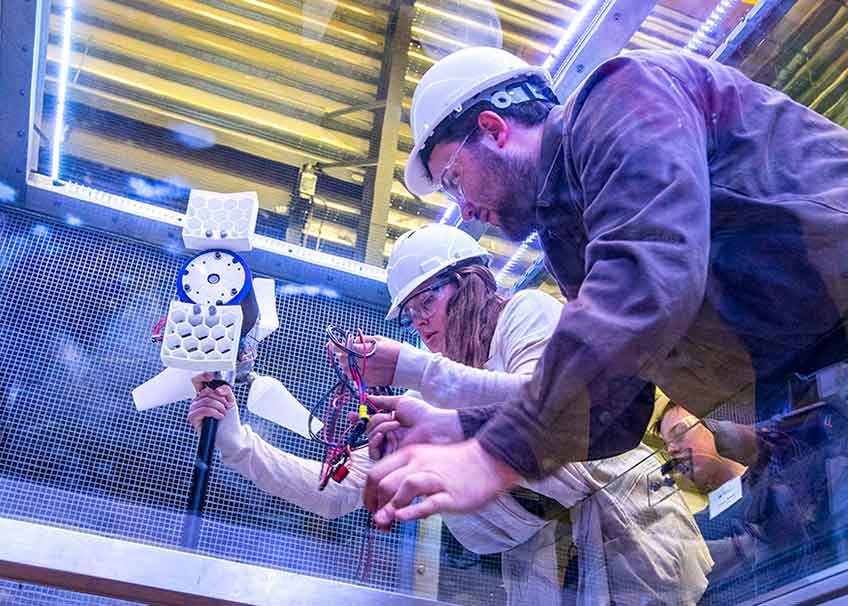Matchmaking Challenge: Wind Workforce Research Helps Bridge Gap Between Employers and Applicants
Webinar Presents Preliminary Survey Data, Highlighting Issues and Possible Solutions

NREL’s wind workforce research seeks to meet growing wind industry demands by improving connectivity between employers and qualified candidates and filling the “wind workforce gap.” Programs such as DOE’s Collegiate Wind Competition (shown in this photo from the 2019 competition) offer competitors the opportunity to engage with industry, helping prepare them for wind energy careers. Photo by Werner Slocum, NREL
Wind energy industry employment grew more than 50% over 5 years—from 77,000 workers in 2015 to 115,000 at the end of 2019, according to the U.S. Energy Employment Report. And yet, 68% of wind energy employers have difficulty filling entry-level jobs, and 83% of students or recent graduates who applied say it is hard to find a position in wind energy.
This disconnect—called the wind workforce gap—is the subject of a recent survey conducted by the National Renewable Energy Laboratory (NREL).
“The wind industry is expected to continue to grow as more capacity is installed across America, and this is going to require a highly trained workforce,” said Jeremy Stefek, an NREL workforce analyst who is leading the wind workforce survey effort. “We designed the survey to help us better understand the wind workforce gap and look for ways to improve connectivity between employers and qualified candidates so that as the industry grows, we’ll be able to meet its workforce demands.”
Funded by the U.S. Department of Energy’s Wind Energy Technologies Office, NREL’s workforce research project sheds light on industry needs, U.S. wind educational programs, and hiring processes, while gathering perspectives from students and recent graduates on their interest in and experiences finding wind industry jobs.
Stefek presented preliminary findings from the survey during a recent webinar, “Understanding the Energy Workforce,” which was the first of a three-part Wind Workforce Webinar Series conducted by NREL in partnership with the American Wind Energy Association.
Lack of Training and Experience Top Industry's List of Hiring Challenges
Conducted by BW Research Partnership on behalf of NREL, the survey received responses from 296 industry representatives. The three main reasons they cite for having trouble filling open entry-level positions across all wind-related occupations are:
- Lack of training or education (29.7%)
- Lack of experience (27.6%)
- Not enough applicants (22.7%).
“A key survey finding is that the wind industry includes many different occupations that each have unique skill sets,” Stefek said. “From manufacturing and construction to research, operations, and siting, finding qualified applicants across these employment areas is a challenge.”
Reasons for Hiring Difficulty
| Industry | Top Reasons Indicated |
|---|---|
| Entry Level | |
| Manufacturing | Lack training or education |
| Research and development | Lack training or education |
| Construction | Not enough applicants |
| Education/Training/Advocacy | Not enough applicants |
| Operations & asset management | Lack experience |
| Development and siting | Lack training or education |
Survey respondents from various sectors in the wind energy industry reported a lack of training or education or lack of experience as sources of hiring difficulty.
Work Location Represents a Key Concern for Students and Recent Graduates
Receiving responses from 769 students and recent graduates from more than 70 U.S. universities and community colleges, the survey also revealed challenges faced by the prospective wind energy industry workforce.
Given a list challenges to gaining employment in the wind industry, students and recent graduates were asked to select all that applied. The following challenges ranked the highest:
- Geographic barriers (66.7%)
- Lack of relevant work and/or industry experience (67.2%)
- The ability to receive hands-on training specific to wind energy careers (61.5%).
“One interesting finding was that the wind industry scored below average in offering the opportunity to work in locations where prospective workers want to live,” Stefek said. “Initial survey results show that it’s more of a challenge for students in suburban and urban areas to find employment opportunities in the wind industry compared to those who live in more rural areas.”
Despite the challenges they encounter finding wind energy employment, students and recent graduates give the wind industry two thumbs-up for aligning with their environmental priorities and offering promising career pathways in terms of pay, benefits packages, and growth opportunities.
When asked about their interest in land-based or offshore wind industry careers, 72% said they are likely to apply for an open land-based position, compared to 63% who indicated they would apply for an offshore wind position.
“This demonstrates that there is a need to educate interested students in the employment opportunities presented by this emerging industry,” Stefek said.
Workforce Connections Help Fill the Gap
NREL’s survey sought to determine where the industry looks for its workforce and how this potential workforce looks for jobs.
“Overall, industry is relying on internships and online hiring websites—while applicants are relying on hiring websites and career fairs,” Stefek said. Over the next several months, he and his team will dive deeper into the survey data to highlight key findings that will support matchmaking efforts to bring employers, employees, and education institutions together.
“The key takeaway from our research so far is that there is a lot of interest in wind energy careers by students, but students and industry are both pointing to experience as one of the barriers to growing the wind energy workforce,” he said. “So, we need to understand how we can better connect students, recent graduates, education institutions, and industry to develop a highly qualified workforce to meet the growing demands of the wind industry.”
Interested in learning more about this research? Access Stefek’s webinar and other webinar recordings in the Wind Workforce Webinar series on NREL’s Learning Channel.
This article has been updated to reflect an editorial change made after its original publication.
Last Updated May 28, 2025
